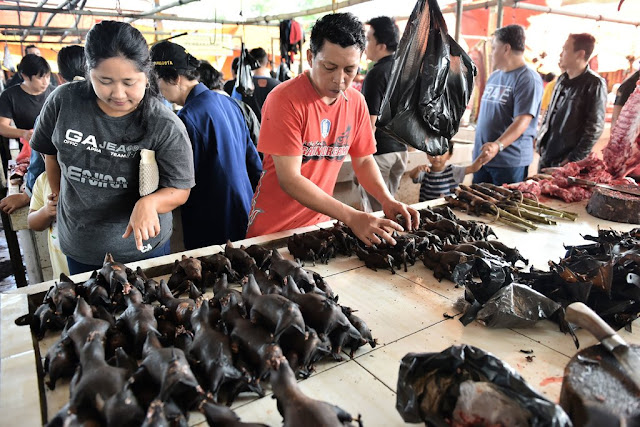 |
| HSUS pic |
There are bats and bats. On a lovely summer evening, we may be tempted
to duck and cover when bat(s) fly over us, little realizing they’re our great backyard
buddies, who wolf down pesty and disease-carrying insects galore -- one bat can
eat up to 1,000 mosquitoes an hour!
Other
bat species also help humans by pollinating fruits (think bananas, avocados
and mangoes) and helping disperse seeds that regenerate tropical forest trees.
We
may sympathize with bats because white nose syndrome (WNS) has killed them by
the millions, or shudder at the thought of rabid bats or vampire bats with
bloody fangs.
 |
| Fruit bat USDA pic |
Clearly, bats prompt mixed feelings. Right now, though – as we shelter at home to
escape Covid-19 – we may curse bats, who, as disease carriers, or vectors, are
believed to have started this hideous worldwide pandemic.
But before dealing with that assumption, let’s
look at bats in general. In fact,
they’re quite interesting creatures if you get past their could-be-scary
appearance to reach the facts about them.
Here are some “bat bits” found in my reading.
The more than 1,200 species of bat --
about a quarter of all mammalian species – are second in number only to rodents. Bats live on every continent except
Antarctica, in proximity to humans and farms.
They’re “the only mammals capable of true and sustained
flight.” More maneuverable than birds,
bats have wings made of
a membrane spread across elongated arm bones and fingers. (Maybe that’s part of what can creep us out
about them.)
Most bats are nocturnal (as we know!) and
most are insectivorous. They hide out of
sight during the day and fly and forage for food (bugs) at night. All roosting upside down, they hibernate in
winter, sometimes in giant colonies.
 |
| NBC News pic |
Bats usually “fall into flight,” starting
to fly by “dropping into the air.” Their
hanging upside down therefore helps them make a quick escape.
Most bats are “microbats,” who can eat
their weight in insects (including wasps, moths and mosquitoes). “Megabats” live in the tropics, where they
eat fruit, nectar and pollen. Only
vampire bats feed on blood, far preferring that of cattle and horses to human
blood.
The longest-lived mammals for their body
size, some bats live up to 40 years in the wild. Little brown bats, 3 ½ inches long and
weighing about ½ ounce, are the most abundant variety in North America.
But . . .
Along
with other mammal groups, bats are natural carriers of coronaviruses, with
different groups of bats carrying different strains. “Coronaviruses and bats have been evolving
together for millions of years.”
 |
| Chinese Horseshoe Bat science source |
Amazingly, one bat can host many different
viruses without getting sick. It’s
theorized that bats developed their immunity during the evolutionary process of
becoming the only flying mammals, when adaptations to flight changed their
immune systems.
The rabies virus is one exception that
they can carry and catch, making them immediately dangerous to other
animals, including us. But 99% of bats
in the world are estimated to be rabies-free.
The
big trouble starts when bats’ coronaviruses directly or indirectly spill over
to other animals, like humans, who eat them, trade them in livestock markets
and invade their territory. Covid-19 began in bats, then
made the jump to another mammal (which one is not yet clear), and then moved
to humans. And here we are.
However,
none of this means bats are to blame for this outbreak. Humans have encroached on the lives of
bats, not vice versa. So humans
must change all the habits and traditions that have brought us to this
pass. And that leads us, again, to the
refrain about leaving wildlife alone – not trading in it or consuming it.
We
could do that, but will we?
 |
| Vendor with bat meat, Indonesia |
#
(If you’ve stayed with me this far, here’s a bonus link to
some interesting-but-tough reading:
To comment on this post, please go to 1moreonce.blogspot.com
– and thanks!
No comments:
Post a Comment